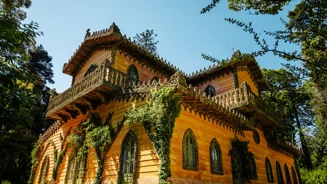The History of the Chalet and Garden of the Countness of Edla

Elise Hensler was born in Switzerland in 1836 before living for many years in Boston, in the United States of America. She was a woman of great culture and had a profound passion for the world of arts and letters and who herself became a professional opera singer. After having studied in Paris and performing in Milan, Elise visited the Portuguese stages and appeared at the São João National Theatre in Oporto before then taking to the São Carlos National Theatre in Lisbon. It was on this latter stage that King Ferdinand II first saw and fell in love with her.
In 1869, with King Luís I already on the throne, Ferdinand II and Elise married, united by their love for arts and culture. The ceremony took place after Ferdinand had requested his cousin, Duke Ernest II of Saxe-Coburg and Gotha, bestow a title on his future wife: the Countess of Edla. Opinions on this marriage taking place, both among the nobility and in the press, remained fairly divided and it was never fully accepted by the public.
The couple turned to Sintra, more specifically to the Park and Palace of Pena, properties owned by Ferdinand II as their refuge. Both held a passion for botany and oversaw an intensification of planting in the park, including species sourced from various parts of the world in their romantic garden.
In one of the setback corners of the park, the couple began the construction of a chalet that was designed and planned by the Countess herself. Both the chalet and the surrounding garden display a profoundly romantic sensitivity. Strategically located to the west of the Palace of Pena, the building is inspired after alpine chalets in a style then very much in fashion across Europe. The chalet incorporates a scenographic dimension that reflects the artistic facets to this couple. With a highly individual taste, its facade and interiors are simply unparalleled. On the outside, the garden surrounding the chalet creates an exotic landscape featuring highlights such as the Fern Garden of the Countess, the Garden of Joina, the Arbor and the Chalet’s Labyrinth of Stone.
Following the death of Ferdinand in 1885, the king left all of his goods and possessions, including the Moorish Castle and the Palace of Pena, to the Countess of Edla. Following a judicial process – which was served with the intent of ensuring this heritage belonged to the Portuguese crown –, Elise ended up selling the Park and Palace of Pena and the Moorish Castle to the state but retaining the right to use the chalet and its respective garden through to 1904.
In 1999, the Chalet of the Countess of Edla was destroyed by fire and only reopening to the public in 2011 following four years of restoration work in which Parques de Sintra carried out the reconstruction of this building of such great cultural, historical and artistic value. This project was distinguished in 2013 by Europa Nostra with the European Union Award for Culture Heritage in the Conservation category.
